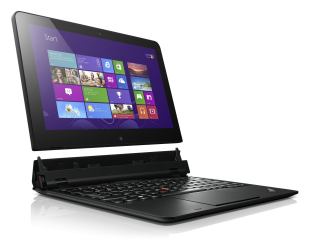A couple of weeks ago I was asked “if you were to choose a second computer, what would it be?”. Thinking this was just a casual survey question I didn’t really give it much thought and answered “I dunno, a Lenovo Helix I suppose”.
Actually there were some good reasons behind that quick answer. I’ve been a long-term ThinkPad user in the past and have always liked the red pointing device in the middle of the keyboard, more so than laptop trackpads. At the time of our laptop refresh earlier this year the Helix wasn’t quite ready, which was a shame because the form-factor and specs were appealing.
I’d almost forgotten answering the question when about a week later an e-mail arrived, telling me that a Helix would be ready for me to collect the week after. I then thought that if I’d known I was actually selecting a second device I would have considered the question a little more carefully. Anyway, the day arrived and I collected the Helix.
If you’re not familiar with the details of the Helix, it goes a bit like this. It’s a tablet, running Windows 8.1… but it’s also a laptop, if you slot the tablet into the keyboard unit. The keyboard is actually more of a dock as it features a full range of ports and also an internal battery which, when added to the tablet’s buttery, boosts the overall running time to over ten hours.
 So, all of the processing power lies within the tablet – an i7 processor, a 256GB SSD, 8GB of RAM, and a rather splendid 1920 x 1080 display behind a touch-screen panel which features full digitiser support. The tablet stores the pen which can be used for handwriting and Windows navigation, and offers a USB port and a mini display port.
So, all of the processing power lies within the tablet – an i7 processor, a 256GB SSD, 8GB of RAM, and a rather splendid 1920 x 1080 display behind a touch-screen panel which features full digitiser support. The tablet stores the pen which can be used for handwriting and Windows navigation, and offers a USB port and a mini display port.
Compared to other tablet / keyboard combos on the market, the docking of the tablet into the keyboard unit seems a bit clunky. However this may be down to two factors – one being that the keyboard is more like a docking station, and the other is that the tablet can be slotted into the keyboard unit reversed. This means it can act as a tablet but with the full range of ports available plus the extended battery power.
I have to be honest, with the tablet docked and acting in ‘laptop’ mode there was really nothing special about the Helix, and I felt good about my choice in the Dell XPS 12. However, later at home I left the keyboard upstairs and used the Helix as a tablet with its pen. This was the Eureka moment. The pen support is incredible – it’s great for navigation but the real strength is in its support for hand-writing recognition. I joke that three year old children have better hand-writing than what I do, but actually it’s not far from the truth. I can write quite quickly and accurately on my Surface RT with a rubber-tipped pen, but the experience of the digitiser on the Helix is something else – and after a bit of practise I’m really picking up speed.
So that’s the point for me – as a tablet the Helix is a wonderful device. It’s light, very fast and responsive, the screen is absolutely first-rate and using the pen is a joy. Yes, I will be leaving the Dell at home more often than I thought l would do.

Wow, pretty expensive. I know that Lenovos are good quality and this has good specs but the price isn’t very competitive.
The thing is there’s loads of tablet / laptop hybrids on the market now, all with slightly different form factors, so it’s difficult to make a direct comparison. Despite what I originally said the Helix does make a good laptop, and it’s an awesome tablet (apart from the lack of kick-stand). Is it worth being twice the price of a Surface Pro? That I’m not sure.
What I would worry about in spending my own money would be longevity. I don’t mean I have doubts about whether the Helix would survive a couple of years of use, I mean how out-of-date will it be even after one year. The technology is improving so quickly. I have an Acer tablet which is just over two years old and it looks like something out of the Ark (even after being upgraded to Windows 8.1).